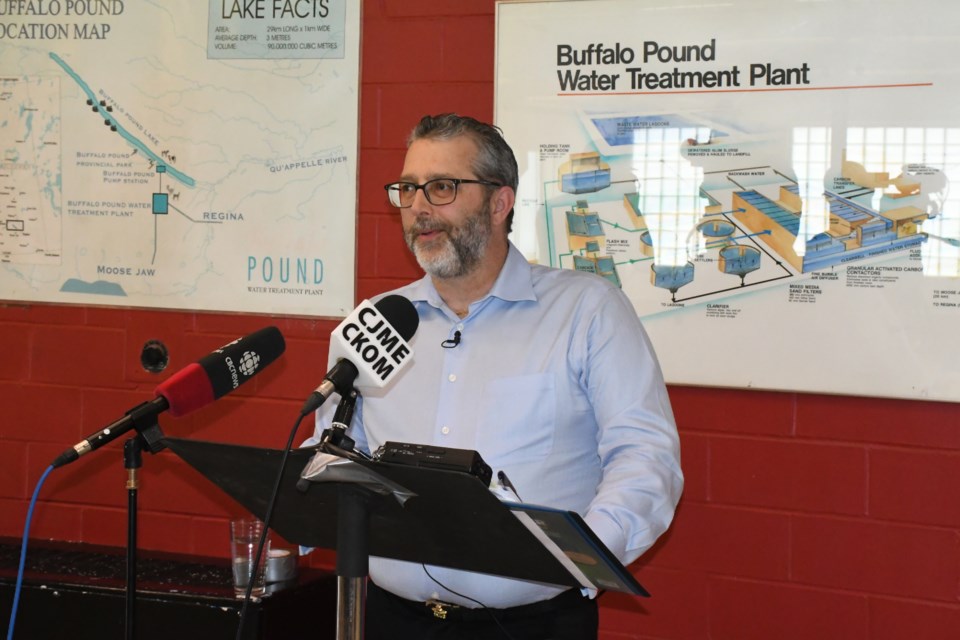Upgrades to the Buffalo Pound Water Treatment Plant will help the venue better handle the lake’s growing range of water conditions, although residents will not likely notice any difference in water quality.
The Buffalo Pound Water Treatment Corporation (BPWTC), which oversees the plant, will start renovations to the sprawling complex in June. Graham Construction-AECON — which has worked on this initiative for the past two years — will handle the renewal project after receiving the contract.
The corporation held a media scrum on May 26 to announce the start of construction and provide details about the renovations.
Time for upgrades
Last updated 30 years ago, the Buffalo Pound Water Treatment Plant (BPWTP) has reached the end of its useful life, explained Ryan Johnson, president/CEO. Water treatment plants typically require major refurbishments every 25 to 30 years, so this project is right on time.
“The plant is in need of upgrading and renewal to ensure the continued delivery of sufficient high-quality water to its (260,000 regional) customers … for years to come,” he said.
Aging infrastructure, a lack of redundancy, dated technology, evolving regulatory requirements, water loss and operating systems with limited controls to address poor and variable sources of raw water are challenges the plant faces and will be addressed with the renovations.
Furthermore, the upgrades will help the plant meet environmental requirements, address OH&S demands, meet regulatory orders, increase capacity to meet future demands by 2050, support regional growth, enhance sustainability, reduce carbon emissions and implement renewable energy.
Also, visually appealing equipment like large augers and screws will be gone, while a new administration building will be constructed that includes laboratories, offices, and maintenance workshops.
“Right now … we have people all over the place. In the newer building, we’ll be more closer together,” Johnson said, noting the new building will be energy efficient, have solar panels, use modern construction materials and have LED lights.
More changes
The plant currently produces 205 million litres (megalitres, ML) of water per day, but that will increase to 250 ML per day after the upgrades.
The current plant — which operates 24/7 — is roughly 9,000 square metres (100,000 square feet) in size, and afterward, will stay roughly that size. Meanwhile, the number of employees — 36 — will remain unchanged.
Construction should finish by 2025, followed by two years of validating the equipment.
Global problems
The project’s cost increased by $72.8 million during the past two years because of the pandemic, supply chain issues, climate change, global logistic bottlenecks, the war in Ukraine, inflation and higher borrowing costs, Johnson said.
Specifically, the pandemic reduced demand for supplies, reduced manufacturing production, led to a shortage of raw materials and products, forced hundreds of container ships to sit idle in ports, and hampered the supply chain, he continued.
Moreover, flooding in British Columbia damaged roads, the war in Ukraine showed that the world is not stable, and there is more risk globally.
“Because of these factors, it has impacted the costs. … in the engineering and construction industry, the cost increase is between 20 and 40 per cent. Our project is around the 30 per cent range,” Johnson said. “Unfortunately, it’s not unusual right now.”
Local problems
The upgrades will ensure the plant always has water and can handle unexpected problems, he continued. For example, the venue experienced frequent power outages over the years, while a major problem in 2015 reduced its production capacity to 25 per cent for nine to 11 days and almost led to water shortages.
Thanks to Regina and Moose Jaw ordering residents to reduce consumption, that didn’t happen.
“That was about as close call as we’ve had in a long time,” Johnson said.
The conditions in Buffalo Pound Lake can also affect how the plant processes the water since a half-degree Celsius change causes particulates to float instead of sink, preventing the plant from thoroughly cleaning the liquid, he continued. However, installing new equipment will allow the venue to skim the material off the top.
Improved water quality
Most changes will happen behind the scenes, so residents won’t notice much difference in the physical structure, Johnson remarked. However, they could eventually notice more consistent water quality, particularly for people with sensitivities.
Customers will see a one-time water-rate increase of 10 cents per cubic metre because of the project, although they will not have to contribute to future capital costs since those will be stable. However, the corporation plans to connect operating costs to yearly cost of living adjustments, so users might see increases on that side.
The Buffalo Pound Water Treatment Plant is 30 kilometres northeast of Moose Jaw.




